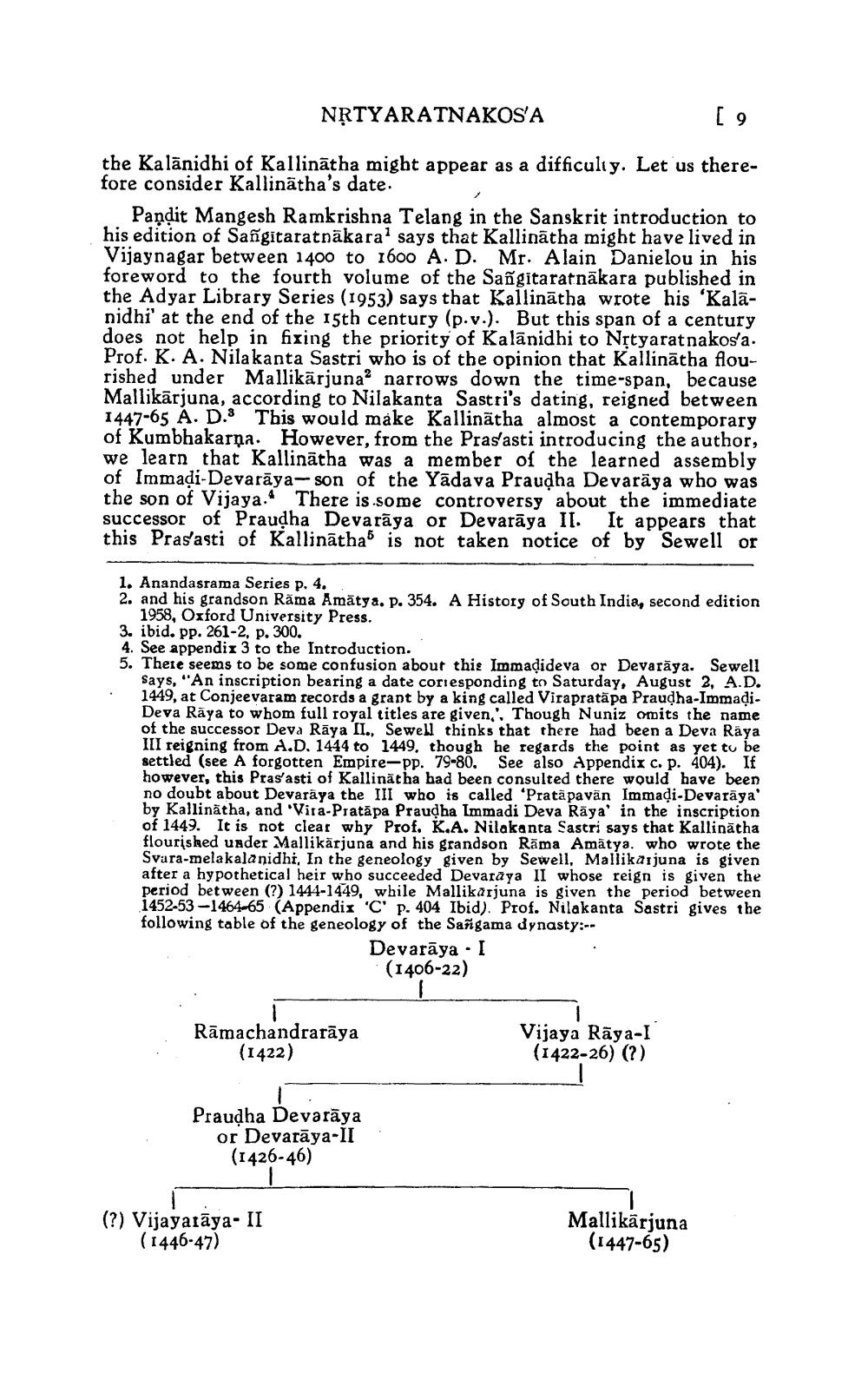________________
NRTYARATNAKOSA
[ 9
the Kalānidhi of Kallinātha might appear as a difficulty. Let us therefore consider Kallinātha's date.
Pandit Mangesh Ramkrishna Telang in the Sanskrit introduction to his edition of Sañgitaratnākara says that Kallinātha might have lived in Vijaynagar between 1400 to 1600 A.D. Mr. Alain Danielou in his foreword to the fourth volume of the Sañgitaratnākara published in the Adyar Library Series (1953) says that Kallinātha wrote his 'Kalānidhi' at the end of the 15th century (p.v.). But this span of a century does not help in fixing the priority of Kalānidhi to Nộtyaratnakosa. Prof. K. A. Nilakanta Sastri who is of the opinion that Kallinātha flourished under Mallikarjuna? narrows down the time-span, because Mallikārjuna, according to Nilakanta Sastri's dating, reigned between 1447-65 A. D. This would make Kallinātha almost a contemporary of Kumbhakarna. However, from the Prasasti introducing the author, we learn that Kallinātha was a member of the learned assembly of Immadi-Devarāya-son of the Yādava Praudha Devarāya who was the son of Vijaya. There is some controversy about the immediate successor of Praudha Devarāya or Devarāya II. It appears that this Prasasti of Kallinātha is not taken notice of by Sewell or
1. Anandasrama Series p. 4.. 2. and his grandson Räma Amātys. p. 354. A History of South India, second edition
1958, Oxford University Press. 3. ibid. pp. 261-2, p. 300. 4. See appendix 3 to the Introduction. 5. There seems to be some confusion about this Immadideva or Devarāya. Sewell
says, "An inscription bearing a date corresponding to Saturday, August 2, A.D. 1449, at Conjeevaram records a grant by a king called Virapratapa Praudha-Immadi. Deva Raya to whom full royal titles are given,'. Though Nuniz omits the name of the successor Deva Raya II., Sewell thinks that there had been a Deva Raya III reigning from A.D. 1444 to 1449, though he regards the point as yet to be settled (see A forgotten Empire-pp. 79-80, See also appendix c. p. 404). If however, this Pras'asti of Kallinātha had been consulted there would have been no doubt about Devarāya the III who is called 'Pratäpavän Immadi-Devarāya' by Kallinätha, and Vira-Piatäpa Praudha Immadi Deva Raya' in the inscription of 1449. It is not clear why Prof. K.A. Nilakanta Sastri says that Kallinātha flourished under Mallikärjuna and his grandson Rāma Amatya. who wrote the Svara-melakalanidhi, In the geneology given by Sewell, Mallikarjuna is given after a hypothetical heir who succeeded Devaraya II whose reign is given the period between (?) 1444-1449, while Mallikarjuna is given the period between 1452-53-1464-65 (Appendix 'C' P-404 Ibid). Prof. Nilakanta Sastri gives the following table of the geneology of the Sangama dynasty:--
Devarāya - 1
(1406-22)
Rāmachandrarāya
(1422)
Vijaya Rāya-I (1422-26) (?)
Praudha Devarāya or Devarāya-II (1426-46)
(?) Vijayarāya- II
(1446-47)
Mallikarjuna
(1447-65)




